Tagged: Blogging
I've been blogging a long time
- by Alyson Shane
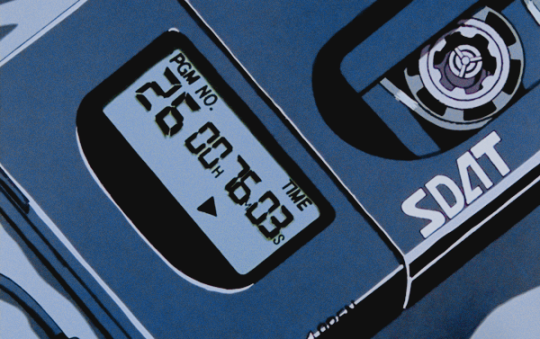
I got my first LiveJournal or maybe Xanga back in 2003 and started writing before it was cool to use your real name on the internet.
We called ourselves dumb stuff like moon_meditation, rainbow__heartache_, planetaryattack_, and Sonic_Cry and, thinking back
we were all really into underscores for some reason.
Nowadays it's cool and almost expected that you use your real name online but back in the day we called our blogs dumb things like
The Lost Planet
Marduk The Invincible's Blog
The Lolita Chronicles
and literally just:
...
We used avatars to set the tone for the way we were feeling with each post. People used Disney images and anime characters and illustrations and animated gifs instead of profile pictures and would cycle through different ones depending on how they felt that day.
At the top of each post we could list a bunch of info, like:
Title:
Date:
Security:
I am...:
I hear...:
I'm feeling...:
and you'd fill it in like so:
Title: Without You I'm Nothing
Date: 11.11.2003
Security: public
I am...: Home sweet home
I hear...: Placebo - Every You Every Me
I'm feeling...: Reflective
I miss those days when blogging was simpler and you could say whatever you wanted.
Back when the internet was young and we poured our hearts here and talked about troubles and heartbreak and didn't give a damn if
things lined up or looked good
or if yr punctuation and grammar wasperfect
because you were writing as fast as you could think, unhindered and unencumbered, and as you poured the words out of your fingertips and onto that digital page you would feel this deep sense of relief and
catharsis
after hitting 'Publish'.
I miss those wild west days.
But being a blogging dinosaur isn't so bad. I've spent nearly two decades working through my bullshit and honing my craft and watching as the way people communicated online has changed
and my blog has changed me just as much as any social media network
but goddamn if I don't still miss using gifs as avatars.
How to Pull Yourself Out of a Creative Slump
- by Alyson Shane
Let's face it: even those of us who run our own businesses doing what we love for a living there are days where we feel more lukewarm than red-hot about it. It's normal! Not every day has to result in bubbly feelings, 110% productivity, and heaps of creative new ideas to jot down.
But what do you do when that dip in productivity becomes a lull... and then the norm?
This totally happened to me recently.
Don't get me wrong: my dedication to my clients hadn't faded, but my creative side - the side that feels like it shows when I write, for example - seemed to be taking a backseat to everything else that was going on in my life.
This is totally normal. It's normal for creative people to go through a dip in productivity, or a drought, but when you depend on your creativity to make a living there's a unique sort of pressure to get yourself together and get producing again.
With that in mind I wanted to share some of the steps I've taken to "get my groove back" so to speak, because you never know when a creative dry spell may occur:
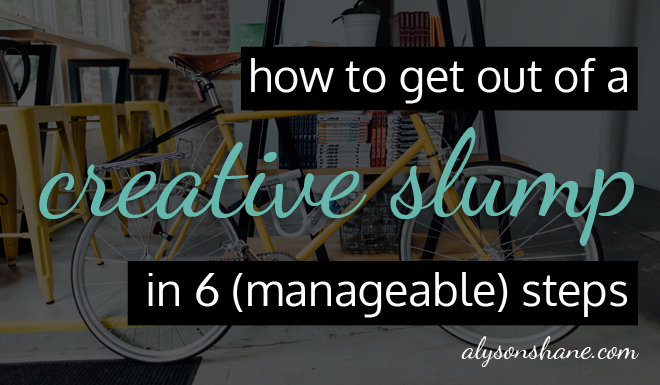
1. Acknowledge there's an issue
This is the worst. When you're in a creative slump it's easy to brush it off and say "I just don't feel like it right now!" or "I'll just get to it later" but you've got to be honest with yourself or you'll never snap out of it. You need to take a long, hard look at your screen (or canvas, or whatever) and admit: I haven't been working as hard at my craft as I usually do, and I need to snap out of it.
It's normal to feel guilty here; just let yourself feel bad for a few minutes... then let it go! The easiest way to make those guilty feelings go away is to do the thing that's making you feel bad, right?
2. Do it even if it sucks
The biggest hurdle to overcoming your creative slump is just sitting down to do the damn thing and not getting overwhelmed to the point where you're too in your head to produce anything of value. So what should you do instead? Sit down and create something of no value.
If you're a writer like me, do some free writing and experiment with different ideas, word combinations, and see what emerges; if you paint, just paint some stuff and let go of the expectation that it has to be your next masterpiece; you get the idea. Getting back into the habit of doing your craft will help you get back to feeling comfortable with it instead of intimidated and anxious.
3. Get active
When my anxiety flares up or I get super busy I'm the worst for letting my trips to the gym fall by the wayside. I try to go 2-3 times a week and I notice a definite slump in my mood, sleep, and creativity levels when I'm not exercising regularly. Recently I "scheduled" GAINZ time into my calendar Monday, Wednesday, and Friday mornings; that way it's just scheduled into my workday.
On days when I can't make it in the morning I try to go in the afternoon, but if all else fails I make a point to go for a walk, ride my bike somewhere, or do yoga at home (I'v also started doing this 10-minute yoga flow video in the afternoons to clear my head - it works, I swear!)
4. Read
Like I said, I've been struggling with a creative slump recently and when I sat down at my laptop today I hadn't intended to write blog post. I've been struggling to write consistently recently, but I still spend a lot of time online reading articles about a wide variety of topics because 1. I'm a voracious reader and 2. I have to in order to stay on top of my game professionally.
In any case, a few days ago John showed me a terrific series of posts on Derek Sivers' blog, one of which is called How to Be Useful to Others. One of the points goes as follows:
3. Share strong opinions.
Strong opinions are very useful to others.
Those who were undecided or ambivalent can just adopt your stance.
But those who disagree can solidify their stance by arguing against yours.
Even if you invent an opinion for the sole sake of argument, boldly sharing a strong opinion is very useful to others.
While it didn't really strike me at the time, those statements have been gnawing at me for a few days and were one of the things that inspired me to sit down and start trying to work past my writer's block. However, you can read whatever inspires you in order to get your spark back: novels, autobiographies of people you admire, or even some articles on Hacker News - whatever leaves you feeling inspred is stuff you should actively be seeking out and reading (or re-reading).
5. Write it out
Sometimes when I find myself struggling to put my thoughts to paper I do "free writing" session. Free writing is a technique where you literally just write whatever comes to mind without stopping to correct spelling, grammar, or focusing on a specific topic.
After reading the aforementioned Derek Sivers article I started typing... and oddly enough the bare bones for this post started to emerge. I wrote about feeling anxious about not writing as much, and as the words appeared on my screen I realized that I was stuck in a cycle of guilt over not creating which was actually stopping me from doing it.
I find this technique is especially helpful before I start writing something a bit more technical (like one of these blog posts) because it really clears out whatever's floating around in your head. Often whenever I find that I'm stuck on an idea or problem a little free writing clears out that mental clutter in no time!
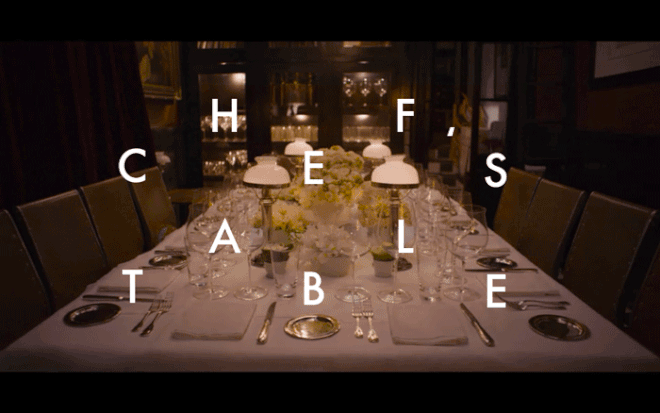
6. Watch & be inspired
I don't usually work with the TV on, but sometimes when I need a little creative background noise (like right now) I'll pop the TV on in the background and half-watch while I work on something. I find that it's best to put on something a bit soothing or slower-paced because watching stuff like action movies can be distracting (hint: don't try to focus on your craft while watching Deadpool).
One of my favourite shows is Chef's Table (it's available on Netflix - go binge-watch it when you're done reading this post!) because not only is it beautifully framed and shot, it also interviews highly creative people who have completely dedicated themselves to their craft and it's pretty impossible to not feel inspired while watching it.
Do you have any tips for getting that creative spark back? Tweet at me or tell me in the comments!
Life Update: Burgers, Tattoos, Cars + VR
- by Alyson Shane
One of the downsides of being a busy business owner is that I don't often get the opportunity to share what I've been up to on a personal level. I'm working on big biz-related surprises which will hopefully help me find more blogger balance (more on that soon!) but in the meantime, here's what I've been up to in the few weeks since I've been back from my trip:
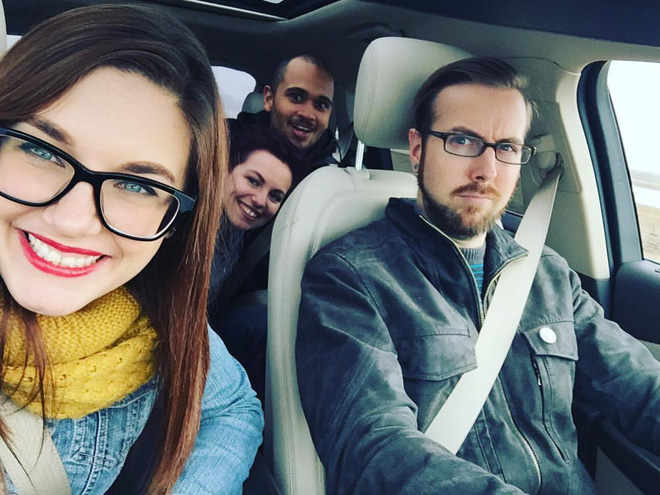
Burgers & Cars
A few weeks ago I had the opportunity to test drive a Lincoln MKX, which is classified as a "luxury crossover vehicle" and is by far the fanciest vehicle I've ever been in. As someone who's spent most of her time in Neons, Vibes, and Swifts (aka, not your mom and pop kinda van) it was a pretty great experience, especially because I don't have a car day-to-day.
With that in mind John and I decided to take the Lenore Street Squad (aka our roommate, Alex and his girlfriend Katrina) on a Manitoba-based day date to try and suss out where we could find the best rural burgers (also because while going to IKEA and cramming the trunk full of stuff is exciting for me, I'm sure you guys could care less about my amazing new lamp, but anyway).

We hit up Trails North Grill, which is a super-charming burger joint located in Warren, MB. We gorged on fried pickles, salad, and (of course) burgers. I'm glad I wasn't driving on the way back because I was officially in a food coma.
Honestly it was also really nice to just get out of the city; I don't often have the chance to get to know my province a bit better, and even though some Silent Hill-esque mist descended upon us for part of the drive, it was still a ton of fun and a great way to spend some time with some of my favourite people.
Tattoos
Tomorrow I'm going under the needle and getting my first-ever tattoo!
While this is obviously a super-exciting event for me, it's also been a very long time coming. The tattoo I've chosen (it's script, actually) is meant to represent where I've come from: from a sad, unhappy and deeply depressed person to someone who does her best to take chances, challenge myself, and who works to make healthy, happy decisions instead of getting dragged back into the mire caused by unhappy and dramatic people.
When I first met with Katie from Metamorphosis for my consultation she told me that she doesn't usually do script tattoos, and as a rule doesn't do them for first-timers like me. However, after explaining my reasoning behind it, and how deeply personal the quote is, she not only agreed to design it for me, but she also told me that it was one of the best script-based tattoo ideas she'd seen in a long time!
What am I getting? Well, you'll just have to check back here and find out once it's all healed up! (Or follow me on Instagram, where I'll likely be sharing it first).
VR
Aka virtual reality!
A few weeks ago John and I spent a few days playing around in virtual reality as part of the trailer shoot for the HTC Vive game Fantastic Contraption and had an utter blast.

(Yes I'm every bit as excited as I look!)
The goal of the game is to create "contraptions" within a virtual space and send them rolling towards a goal while avoiding obstacles, staying balanced, and not rolling right off of the edge of the floating island you're standing on. The game is insanely fun and I'm really, really looking forward to playing it again soon.
Here's a little more about the game (featuring older trailer footage):
The coolest part about the shoot was that, since it was shot on a green screen background, the VR world that the player can see inside the headset can be stitched in to replace the physical world. This allows people watching the trailer to actually see what we saw, and experience the game in the same VR world that we did.
I definitely need to give a huge shout-out to the super-talented Kert Gartner for including us. I'm so excited to see the project when it's finished (and am always available for any future VR-related projects, hehe).
How to Get Your Start as a Digital Marketer
- by Alyson Shane
A few weeks ago, while travelling around Central America, I received a comment on my Instagram which I wanted to take the chance to respond to here on the blog. Here's the question:
How did you get started doing social media marketing? I am interested in this but have no current knowledge of marketing.
-Brittany T.
Instagram isn't the best way to answer a questions like this in an in-depth way and I've been chomping at the bit to get home and write a longer, more detailed response because I wish someone had told me all of this stuff back when I was trying to figure out what I want to do.
Not only because it's great to hear what other people did to get to where they are in life, but also because being a digital marketer isn't really something that anyone worth their salt can just start doing successfully. That's because there's a lot of ongoing effort that goes into crafting a personal brand that people (freelance clients or future employers) will feel comfortable handing their social profiles over to.
So without further ado, here we go:
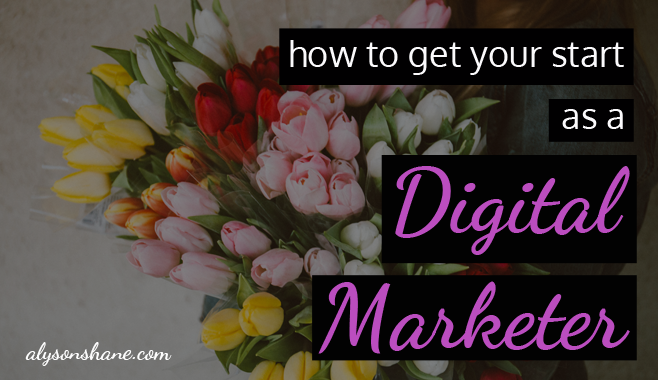
Build your personal brand
Your "personal brand" is exactly what it sounds like: it's the image of yourself that you project out into the world through your words, your actions, and your behaviour.
What's beautiful about the internet is that you can craft your personal brand to reflect whatever parts of yourself you'd like to accentuate.
This takes time. People aren't going to start recognizing your name overnight, and
The more time you spend working on and crafting your personal brand, the stronger your image will be and the sooner opportunities will start coming your way based on people's perceptions of you. Your audience will see you as a sincere, intelligent person and will be breaking down the door to work with you. I wrote more about personal branding here.
Build a badass website
I've said this before, but your website should be the centre of everything you do online; all of your social media feeds should attempt to drive traffic back to your website, and it should clearly and succinctly explain to people who you are, what you do, and what you're about.
Make your website as easy to navigate as possible. Try to aim for a slick, clean layout without a lot of clutter, and try to use bright, eye-catching photos. Personally I prefer websites with a white background and dark font, because it's easier to read and looks cleaner, but do what works for you.
Start blogging
I've been blogging since 2003, and the latest iteration of my blog (what you're reading right now) has been active since 2009. In that time I've transitioned from being a "lifestyle blogger" to someone who, largely, writes about their profession, but what matters is that I've been publishing content online for a long time.
Regardless of the topic, maintaining a blog for an extended period of time looks great professionally. Here's why:
- It's the best way for you to showcase who you really are in more than 140 characters.
- It shows that you can commit to an ongoing project (blogging).
- It demonstrates your writing skills.
Blogging has helped me establish myself as someone who understands their industry, is a strong writer, and has allowed me to expand my audience. My blog has allowed me to speak at MBlog, get published in the Winnipeg Free Press, and even to get featured on ShawTV as one of Winnipeg's Hottest Bloggers. When I was applying for jobs all of my employers checked out my blog, and it's the first place most of my clients find me nowadays.
But... what if you hate writing?
I get asked this question a lot, and to be honest I never really know how to respond to it. In my view, people who are interested in social media enough that they want to do it professionally should have a deep interest in how we communicate online and how we use persuasive language (aka rhetoric).
Because let's be serious: someone in my position spends most of their days writing in one form or another. Maybe it's website copy, maybe it's scheduling tweets, maybe it's writing a blog post or a newsletter, but either way all day every day, we're hustlin' writing.
If you don't like writing and understanding the nitty-gritty of how we communicate with each other... maybe this isn't the profession for you.
Having a social media presence
I can't stress this one enough.
If you are genuinely serious about pursuing a career as a social media manager or digital marketer, you need to jump into social media feet-first and do your best to maintain an active presence on platforms which will help you get a bit more well-known. I prefer Twitter for this purpose, personally, but if you don't have at least a Facebook profile, Twitter presence, and Instagram account, it's unlikely that prospective clients will take you seriously.
This is because how well you manage your own accounts gives people an insight into the kind of person that you are (are you nice online, for example), demonstrates that you know your way around at least a few of the major communication platforms, and shoes that you're relevant because you update them all regularly.
Oh, right: update them all regularly. This is key. Nobody is going to take someone who sells their services managing and understanding social media platforms seriously if their last tweet was from 2014.
Not just that, but social media is the easiest way to share that blog content that we talked about earlier. Cross-promoting yourself across a variety of social networks is one of the easiest ways to get noticed by a potential employer or client.
Show up to local Meetups
This expands a bit on the earlier point about building your personal brand: while connecting online is great, it's important to turn those digital connections into real, face-to-face ones, and the easiest way to do that is to show up to things.
If you're in Winnipeg, there are plenty of opportunities to connect and get known. Some of them are:
- Winnipeg Social Media & Technology Group
- BANG! Business and Networking Group
- I Love Marketing Winnipeg
- Secret Handshake (I'm usually at this one - say hi to me if you see me there!)
Not in Winnipeg? Check out Meetup.com for local social media-related gatherings near you!
Let your passions drive you
I believe that being passionate about what you do is the single most important asset in this equation.
While I make my living as a digital marketer, I actually identify as a writer. That's it. I love to write, and am obsessed by rhetoric (aka persuasive language) and the ever-evolving nature of social media, so applying what I love to do (writing) to something that interests me (communication/social media) just made sense.
If you aren't passionate about what you do, then you won't take the time to explore it and understand it, and part of being an effective digital marketer is keeping up with the ever-changing trends in your industry. Not just that, but if the idea of developing marketing plans for Instagram, or spending your days monitoring @ mentions on Twitter doesn't make your heart go pitter-pat, then you may want to rethink your career choice.
A lot of this comes down to perspective, too: like I said, I identify as a writer above all else, and managing social media profiles, developing copy for marketing strategies, and keeping up-to-date on how to effectively communicate on each platform (to hashtag, or not to hashtag? That is the question!) is just another way to sharpen my writer's chops.
So, figure out what you love the most about social media and make that your focus.
Hopefully that helps, Brittany! Good luck to you on your career journey!
Do you have any questions for me about being a business owner, digital marketing, social media, or anything I mentioned in this post? Ask me in the comments or drop me a line - I'm always happy to hear from you!
How to Build a Killer Digital Marketing Strategy
- by Alyson Shane
We live in tumultuous digital times, my friends. New social networks seem to be appearing every day, and if you're trying to promote your business online, it's easy to feel like there are too many options to choose from.
Most clients I talk to when we first meet have an ad-hoc strategy when it comes to promoting themselves online; they know of a few social networks and have accounts set up, but in many cases their messaging is muddled, unclear, and in many instances they are trying to reach an audience who simply aren't there.
That's why developing a digital marketing strategy is so important. Having a strategy which has taken into consideration both your brand's needs and those of your audience and customers can make or break your marketing efforts, so today let's go over some steps to build a badass digital marketing strategy to help you stand out online:
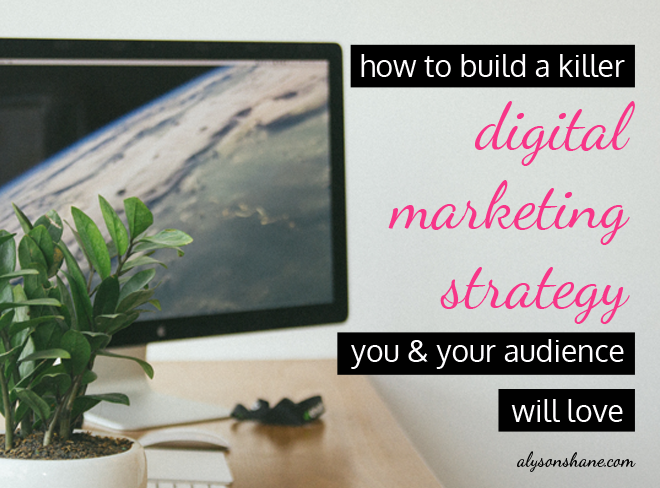
Determine your goals
The first thing I ask a prospective client is: what do you want your digital marketing strategy to accomplish? Many people have never thought about this before, and if you haven't until just now, that's okay! But now is the time to start thinking about what all the time and effort is going to do for you.
When I was in university, I took a few business courses where I learned about two crucial acronyms for planning that I still use every day: SWOT and SMART.
SWOT stands for Strengths, Weaknesses, Opportunities, and Threats, and is helpful when planning a project or new business venture so you can assess (you guessed it) your strengths and shortcomings before moving forward.
SMART stands for Specific, Measurable, Attainable, Realistic, and Timely. When planning out your goals for your digital marketing strategy, make sure that they all meet this set of criteria. What do you want to accomplish and how will you measure it? What are realistic and attainable goals to aim for?
Understanding your SWOT and SMART goals will help direct your time and energy, so you don't waste time floundering around, trying this or that, instead of having a focused and easy-to-understand set of goals.
Ask "Why me?"
What I mean by this is: ask yourself why your business exists.
What does your organization (or your small business) do that makes you worth working with? Are you a Twitter whiz? Do you write fantastic, eye-catching copy? Are your presentation and PowerPoint (or Keynote) skills second-to-none? How do your skills and your personality set your business apart from your competition?
This may take some digging and soul-searching, and that's okay! Many of us (myself included) have had to take a hard, critical look at our business and suss out what makes us unique, and how we can convey that to our audience and potential customers.
Tell your story
Crafting a narrative about your brand is one of the most important things you can do online. Your story -what makes you unique, different, and perfectly posed to solve your customer's problems - is what sets you apart from your competition.
Humans are natural storytellers, and people will be attracted to and remember a brand whose story made them feel something. Positive feelings also lead to feelings of trust, comfort, and help shape your brand's identity not just as a company, but as somewhere where real, dedicated people work and put their energy into.
(Want more info on brand storytelling? Check out my post Marketing Your Brand Through Storytelling)
Build your buyer personas
A buyer persona is exactly what it sounds like: a fake profile of the kinds of people you want to attract and engage with online.
A complete persona should have details about the person's background (I like to name my buyers, too), what they do for a living, what their values and beliefs are, what they like and don't like, and what motivates their decision-making process.
Developing buyer personas is one of the most important steps you can take as part of your digital marketing strategy because it gives you a deeper insight into what your ideal customers are looking for online. This information will inform the kind of things you say, what you share, and the people you connect with online.
Identify where your audience will be
This is critical to implementing a successful digital strategy because if you don't take the time to figure out where your target audience is hanging out online, then you'll never be able to reach them and show them how awesome you are.
That's why doing a buyer persona is so important: it doesn't just inform what to say and how to say it, but also where you should be saying it for maximum impact. For example, if your target audience are Etsy obsessed DIYers who love Pinterest, spending all your time marketing on LinkedIn, which is a business networking site, isn't going to help you find your audience anytime soon.
Take time to think about where your ideal customers will be spending their time thinking about the things that interest them online, and how you can make yourself stand out so they notice you.
Track your success & pivot when necessary
Social networks change over time, so it's important to keep an eye on how successful your digital strategy is, and to fine-tune as you go along. Paying attention to the statistics of each social media account (and your website, if you're blogging, too) can go a long way towards informing what kind of content is resonating your audience, and which turned out to be rather lackluster.
What's wonderful about digital marketing is that unless you really screw up, your audience will usually forgive and forget about a post that didn't catch their eye, or a tweet that didn't go as viral as you hoped. This means you can experiment with different kinds of images, polls, contests, and more! Just track how successful each one was and try to duplicate the ones that did well.
Ask for help (if you need it)
Developing a robust digital strategy can be challenging and time-consuming, and even when brands and businesses have buyer personas they often can't (or don't want to) spend the time reaching out to them and connecting.
That's totally okay! You are not a machine designed for selling and promoting, and if you feel overwhelmed at the thought of having to run your business and develop and implement a digital marketing strategy, that's normal.
Many people choose to work with business consultants, who can help you determine the right direction for your company and develop a killer digital strategy to go along with it (I recommend Kyla Roma if you're in the market for someone; she's fabulous). There are also people like me who offer content management services to help keep you on track (shameless plug, haha).
There's no shame in asking for help, so if you're feeling baffled or overwhelmed make a point to reach out to someone and get the ball rolling on developing and implementing your shiny, new digital marketing strategy!
Do you have any questions about digital marketing? Do you want to know more about how to implement a killer online strategy? I'd love to know!
4 Easy Ways to Reduce Your Blog Bounce Rate
- by Alyson Shane
Whether you blog for yourself, your business, or your employer, minimizing your blog's bounce rate should be a top priority. Readers who click on your site are much more likely to come back than the ones who don't, so managing your bounce rate can go a long way towards building your audience.
If you haven't heard this term before, your blog's bounce rate is the percentage of visitors who arrive on your site, stay on one page, and then leave without clicking around.
This might not seem like a big deal - after all, if they clicked on a link you shared to get to your site, then didn't you accomplish your goal? Well... sort of.
Why is your bounce rate important?
If you run a blog simply for the sake of writing about your life or your interests, then maybe your bounce rate isn't that important to you.
But if you're anything like the millions of bloggers, artists & creatives, and businesses who feature a blog as a single section of a website designed to sell a product or service, then making sure that your site aims to encourage users to explore your site should be a top priority. You don't want them to visit your blog without looking at everything else that you have to offer, do you?
What is a "good" bounce rate?
According to this article, most websites will see bounce rates fall somewhere between 26% and 70%, so as long as you fall within that range, depending on what you do and the purpose of your website, you should be okay.
The same article cautions that a bounce rate below 20% or over 90% is usually a bad sign. The former hints at a problem with the analytics setup, the latter with the website. If you've never taken a look at your bounce rate before, you can find it in Google Analytics (which you should have installed!)
How can you reduce your bounce rate?
I'm glad you asked! It's not as difficult as it may seem, and with a few tweaks and adjustments, your blog will soon be converting like crazy.
Below are four easy ways to spruce up your blog, make it visiting better experience for your audience, and to reduce that bounce rate:

1. Improve your site's speed
Sites that load slowly are my biggest pet peeve! There's nothing worse than waiting for a website to load, or (even worse) try to navigate one which keeps refreshing because the image files take longer to load than the text (I'm looking at you, every single Huffington Post article).
If you're like me the most likely culprit is huge image files or lots of videos; I just did a speed check and managed to get my speed up by 60% by resizing just three photos. Oops. Now my website loads faster than 79% of all tested websites on pingdom.com.
Want to see how quickly your site loads? Punch your URL in here and take a look!
2. Use a clean, easy-to-navigate design
Remember when the internet looked like this?
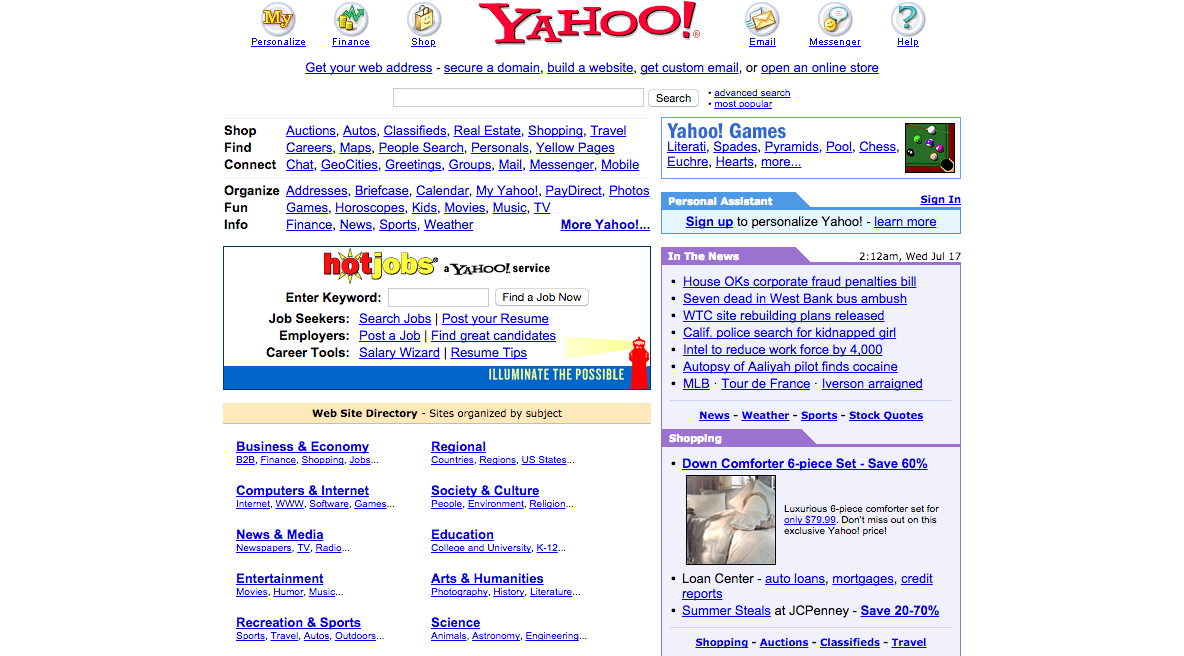
My eyes.
Unfortunately, many websites still look a lot like this, with people trying to cram too much information onto a page at once, providing a visually unappealing and difficult to navigate and read experience for a first-time visitor.
Your website should be designed to move your readers on a journey through your site (generally called a "sales tunnel" but the same idea applies whether you're selling something or not), from the first post they read to other important areas, such as your newsletter signup page, contact form, or online store. If you're struggling to cut back on the content on your page, make a list of the most important parts of your site (e.g., your blog, your About page, your services page, etc.) and try to remove links that don't lead visitors to those areas.
Also, this should also go without saying, but you should also make sure that your site is mobile responsive (aka that it resizes to fit the width of the screen on a mobile phone). Trying to read and navigate a website which hasn't been optimized on mobile screens is a nightmare, and is one of the easiest ways to make sure that first-time visitors to your blog never come back.
3. Keep your content relevant to visitor's needs
What do you blog about? Take a look at the posts you've written recently, and then take a look at your Google Analytics. Are the search terms that are leading people to your website the same ones that you're writing about? If not, then it's time to start honing your content strategy, and then to start paying attention to how you use your headings and subheadings.
Not only does using proper headings and subheadings make your posts easy to read and understand, but it also helps boost your search engine rankings. This is because sites like Google pull information about your page based on what's in your H1, H2, H3, etc., and will help make sure that the people arriving at your site are coming there for the information that you're providing.
4. Link to related posts
One of the easiest ways to reduce your bounce rate is to offer your readers with more to do on your site once they've finished reading. Most bloggers (myself included) just add a footer to the bottom of our posts which recommend posts in the same or similar categories. Adding this at the end of a post is an easy way to entice your new visitor to explore more of what you have to say.
In addition to the footer trick, I also organize my posts into categories so my readers can quickly browse all of the posts I've written on a single topic.They can also browse posts by category and by month and year, and see a list of the most recent posts I've published on the right-hand sidebar.
Try experimenting with your layout and see how you can entice your visitors into exploring of your blog content!
That's it!
By making these changes we've not only managed to increase your blog's look, feel, and navigation, but we've also made sure that your visitors who care about your content can find you, and that your site's slow response time doesn't drive them away before they get through the first paragraph of your latest post.
Have you had issues with high bounce rates? If so, how did you solve them? I'd love to know!
In My Community: Speaking to Red River College's Creative Communication Students
- by Alyson Shane
Earlier today I had the pleasure of speaking to students in their first year of the Red River College's Creative Communications program (aka #CreComm) about the state of social media, blogging, and the future of digital communication with my longtime internet pal Liz Hover.
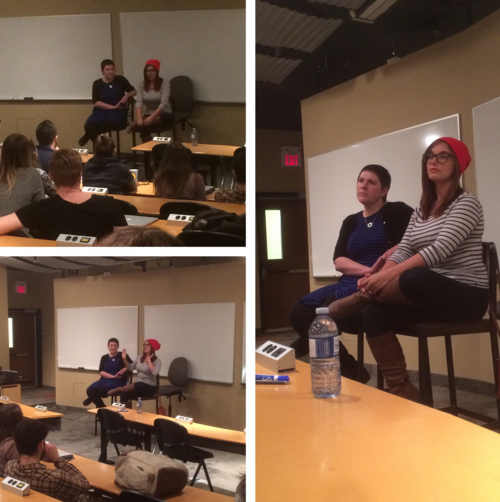
(Really digging my Neil DeGrase Tyson hands in the bottom left, by the way)
This is actually my fifth year returning to speak to students in the program (my first time was in 2011 - how time flies!) and every year it gets better; not just because I get to see new faces and have brand new discussions, but because as my life has changed I've become better suited to be able to speak on these topics, going from a university student, to a university graduate, to being employed full-time and finally to running a business where I literally blog and do social media all day.
As usual, we didn't have enough time to cover everything that I wanted to speak about, so I wanted to cover a few topics that didn't really wrap up during my time with the students today.
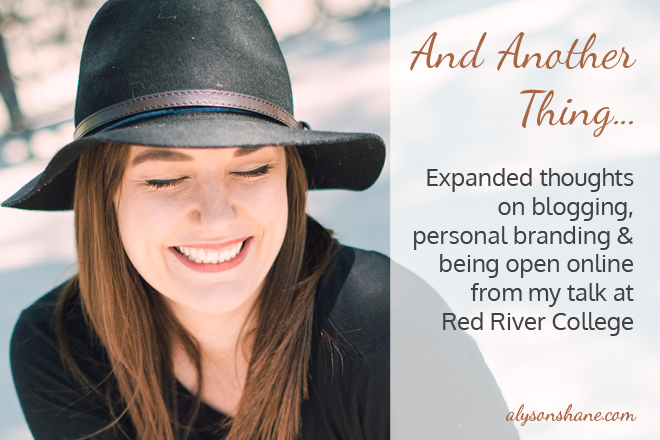
Merging My Personal Brand & Business
I started off as a lifestyle blogger in 2003, back on LiveJournal, and spent a number of years blogging rather aimlessly and not with a lot of purpose. I blogged frequently, sure, but it was usually just about what I'd done on the weekend, or a video I liked, or whatever.
What I had at the time was a strong personal brand, but as I started to think more critically about my craft I wanted to write about my weekends less and less, and about social media, content marketing, and being a business owner more and more.
Blogging for my business gives my blog a sense of purpose, and has provided me with a theme to tie together a lot of topics and ideas which would have seemed weird to write about as a lifestyle blogger.
During our talk Liz turned to me and said "I like your blog now; you seem a lot more happy and positive" and that's because I am. My lifestyle blog chronicled a time in my life where I was largely unhappy and trying to figure myself out, and as I've grown, learned, and gained happiness and confidence as a result of running my business it's translated into what I write here on my blog.
It's totally okay (and normal, and expected) that your blog will change and grow as you do over time - that's okay! We're in a constant state of self-discovery, and our blogs and websites should be a reflection of that.
On Having Anxiety & Being Open About It
One of the things that we touched on in the class, and which several students asked me about afterward, was how I dealt with being an anxious person, and what led me to decide to share some of my personal struggles with my audience when some of them could be potential clients.
I first wrote publicly about my issues with anxiety for Bell Lets Talk Day in 2015. The post is called Living With the Mean Reds and it was one of the most popular posts I've ever written. Since then I've blogged about my progress, which apps I've used to help manage it, and even written about my falling-out with my family, and creating a family of choice to move forward in positive and constructive ways.
None of it is easy to write about, and one of my other family members cautioned me that writing about this side of my life may actually alienate potential employers or clients. My response to that is: if having anxiety or issues with my family stops someone from wanting to work with me, then we wouldn't have been a great fit anyway.
I'm going to do what I want and the kinds of people who respect and appreciate what I have to say will find me and want to work with me. It's worked out great so far.
Besides that, as our digital world becomes less and less private, the onus is on us as individuals to take the time to craft the narratives we want about ourselves online. Sure, you can't control what other people say (remember The Dirty? Omg) but going out of your way to craft your own narrative is an important part of creating your personal brand because even though we like to paint pretty pictures of ourselves online we all know deep down that there are hard times and dark days, and part of being an authentic and relatable human being is being honest with yourself and your audience about your struggles, even if that's challenging sometimes.
What If Blogging Isn't Your Thing?
Creative Communications students have to blog as part of their curriculum, and during our talk we touched on the fact that - let's face it - blogging may not be for everybody. Which I agree with; writing isn't easy for some people.
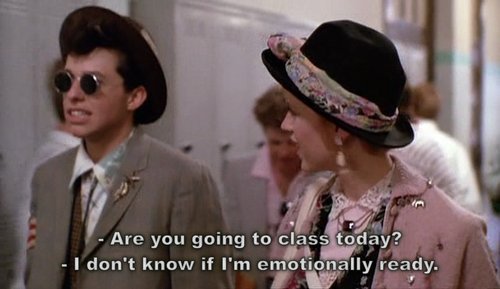
However, I do think that it's important that young people who are entering job markets which require them to be creative (eg: digital marketing, advertising, public relations, etc) should make a point to find a way to express themselves creatively online in a way that they can point to in an interview and say "this is mine."
Blogs also don't have to last forever. My good friend Luke is running year24.com a blog about (you guessed it) his 24th year. This project is on the easy side because he set the parameters himself, and there's a concrete start and end date. What matters is that he made a decision to do something creative and challenging, and was successful in doing so.
But maybe you really hate blogging for yourself, and the idea of holding a camera not attached to your iPhone scares the living daylights out of you. What can you do?
There are a variety of things: start a killer Instagram account about your pet like Liz did; reach out to publications online and start writing for them (one of the very first places I was published online was The Spill Magazine, for example); start interviewing local business owners that you admire and compile them on a website; create and grow a killer Pinterest community; you get the drift.
What matters is that you demonstrate that you're constantly learning, looking for new challenges and opportunities, and can present what you know in a fun and accessible way. The sky is really the limit!
Want More?
Do you have questions about blogging, social media, or how the heck I got to where I am?
Are you a teacher interested in having me visit your class to speak about blogging, social media and digital marketing to your students?
Drop me a line! I'm always happy to have a quick email exchange, a lunchtime chat, or even an after-hours pint at the Yellow Dog. Looking forward to hearing from you!
*As always, thanks to Kenton Larson at Red River College for having me!
Simple Steps to Build Your Personal Brand
- by Alyson Shane
If you're anything like me, you spend an egregious amount of time online chatting, sharing comments, articles and opinions, and connecting with other people.
If you don't, or if you're just starting to, then you may not be familiar with the concept of personal branding, and how it can help you achieve your personal and business goals.
What Is Personal Branding?
Your personal brand is how people in your community and the world at large think about you. It's the sum-total of all of your activity online, which helps paint a picture of who you are to the people who know you through online social channels like Facebook, Twitter, LinkedIn, Pinterest (to name a few), and your website, if you've got one.
Having an understanding of personal branding is a powerful tool because it allows you to actively shape how people see you, and gives a focus and direction of the tone, quality, and direction of the content you share.
In this post we're going to cover a few simple ways that you can build a strong personal brand which not only reflects the fabulous person that you are, but also how it can help you achieve your goals!
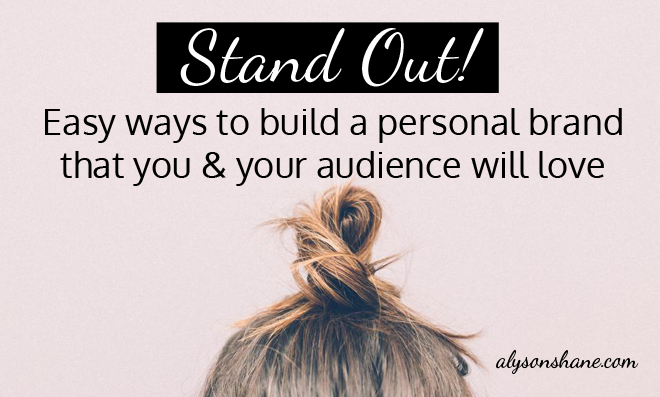
Build a Website That Reflects Who You Are
I'd argue that the most important piece of the puzzle regarding your personal brand is having a website that you love. Something sleek, cool, easy-to-navigate and which accurately represents who you are to the world.
Your website should have an active blog, and should act as the hub for all of your activity online, with your social media feeds regularly linking back to it. Blogging not only helps with SEO (search engine optimization) which is how people find your website, but also helps people gain a better understanding of who you are through what you write and share.
Back in the day people (like me) wrote lifestyle blogs, which were basically like online journals and didn't really exist to serve a purpose other than somewhere for us to publish our thoughts. These days, though lifestyle blogs still exist, they aren't as frequent, and blogging has taken on a more professional quality.
If you're a professional, blogging regularly about events in your industry and sharing ideas and opinions is a great way to help your audience understand who you are. Though I'd argue that lifestyle blogging even has a place, too! While blogging about your industry is great, people still want to see who you are, which is why sharing posts about things you've done, events you've attended, or experiences that you've had are also valuable content.
Explore & Be Your Authentic Self
I write about authenticity a lot, and one of the reasons that I keep coming back to it is because who you are and how you craft your personal brand can make or break your future prospects. if people think you suck, they won't want to work with you.
Luckily being your authentic self is easy: you just have to be who you are.
I've read suggestions on other blogs and websites that suggest trying to craft a "fake" version of yourself; someone who reacts to things differently than you normally would, and makes statements that contradict how you actually feel about an issue. I totally disagree with these suggestions.
Personal branding is about nurturing the best parts of ourselves, being honest and vulnerable, and sharing those parts of ourselves with the world. We're all flawed human beings who are in a constant state of growth, and part of crafting a personal brand is being open about who we are, in as much (or as little) detail as we're comfortable sharing.
Some key things that your personal brand helps people understand are:
- What do you believe?
- What are your goals and ambitions?
- What are your strengths and weaknesses?
- What kind of client/contractor/employee/business owner are you?
- On a scale of 1-10, how much do you love inspirational sloths?

(okay, that last one was just me)
Remember: people connect with other people. Being authentic builds trust.
If you don't appear to be a real human being, or seem like you're faking your way through everything (aka being full of shit) how will people trust you it they don't feel like they know the real you?
One last thing:
Being your authentic self also means that you'll rub people the wrong way. There's always going to be someone out there, naysaying whatever you blog about, share, or reflect on publicly. That's okay. To quote the ever-wise Taylor Swift "the haters gonna hate, hate, hate, hate, hate."
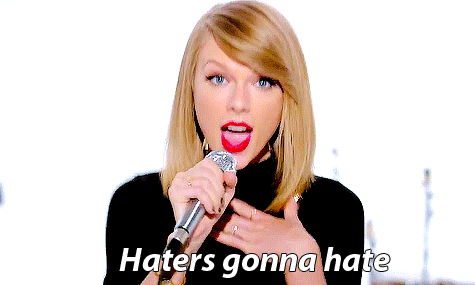
Get Speaking
One of the easiest ways to build up your personal brand is to speak publicly about what you do. Whether it's at a conference, a local meetup, or to a classroom full of students, speaking about what you do not only builds awareness of you and your personal brand, but (bonus!) it'll help you be better at what you do.
If you're not used to speaking it can be really daunting, but a bit of practice and some great reference material (I like to make my own slides using Keynote) you'll have a whip-smart presentation in no time. Additionally, having to break down complex ideas, concepts, or speak about your strategy or workflow can be immensely helpful in helping you develop clearer way to communicate it to everyone else.
Case in point: last April I spoke about the importance of social media at the Manitoba Trucking Association's Driving the Future conference. While I discuss social media with my peers and clients on a regular basis, having to explain things like Twitter to a non-user helped me develop a better understanding of how to convey important ideas. That presentation is what led me to develop my Twitter for Beginners series. How cool!
When you speak do so from a place of knowledge and power and show that you know what you're talking about. Speaking engagements not only help people understand what you do and who you are, but they're also terrific confidence-builders, too. Win/win!
Write About What You Do & Participate in Interviews
Thought leadership articles (like the one you're reading) which provide advice, insight and reflection into what you do help give you major cred. Thought leadership articles not only give you the opportunity to discuss what you do from the comfort of your own keyboard, but can also provide valuable research and learning opportunities as you fact-check and find references to back yourself up, as well (cha-ching!)
I'm a big proponent of knowledge sharing, and I believe that it's single best way to make people aware of what I do. Not just that, but it helps people, too! How awesome is that?
Regularly writing authentic, helpful content is one of the best tools at your disposal to help build awareness of your personal brand, and establish trust between yourself and your audience.
Bonus points:
The more content you share, the more likely it becomes that people will reach out to you for interviews, commentary, advice, collaborative opportunities, and work!
Maintain Your Online Presence
If you don't have social media profiles, now is the time to start setting them up! While publishing thoughtful content on your website is great, you need to have an active presence on relevant social media sites in order to share your content and push people back to the 'hub' of your personal brand (aka your website.)
Here are some questions to ask yourself when going over your social media profiles:
- Do they all contain relevant information?
- Do they link back to your website?
- Are you presenting yourself in the best way possible?*
- Are you using high-quality photos?
- Are you interacting with others and sharing their content in addition to your own?
* What I mean is this: no ranting, no sub-tweeting/vaguebooking, no snarky comments, no racist/prejudiced/inflammatory remarks. While jokes, comments and etc may be okay in person and around specific friends, this type of behaviour is something that you should actively avoid doing whenever possible. It just looks bad, m'kay?
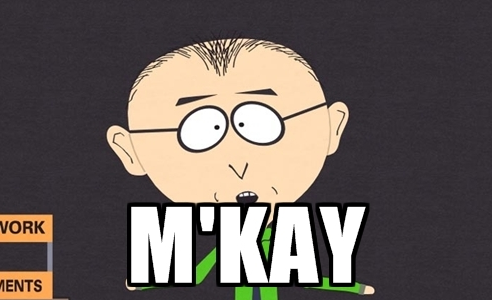
Never Stop Learning
This applies no matter what industry you're in. The world is changing quickly, and we all have a responsibility to stay as informed and up-to-date on the latest changes and trends in our respective industries.
Building a strong personal brand takes time, and if you don't stay relevant then you'll fall by the wayside and all of that time you spent building it up will be for nothing. I regularly hit up sites like Hacker News and Social Media Examiner to stay informed of goings-on in my industry - I'd be lost without them!
Bonus: sharing about what you've learned, or writing a blog post about a topic you've been reading about it a great way to create some original content. Remember: people are coming to your website because they want to hear your thoughts; they could easily go anywhere else, but they came to you. Make sure you're rewarding your audience with well-researched and current opinions and facts.
The more time you spend working on and crafting your personal brand, the stronger your image will be and the sooner opportunities will start coming your way based on people's perceptions of you. Your audience will see you as a sincere, intelligent person and will be breaking down the door to work with you.
Did I miss anything, or do you have something to add to this post? If so, leave a comment,shoot me an email, or tweet at me on Twitter!
How to Go From Novice to Pro: Actionables to Make Your Blog Better
- by Alyson Shane
We live in a world where content is king - the more quality, share-able stuff you publish on your blog increases the likelihood that people will find you and keep coming back.
While this is all well and good, all the great content in the world can't overcome a layout that is difficult to navigate, or physically hurts to look at.
Whether you're brand-new to blogging or feel like it's time to update your blog layout to reflect the savvy, experienced blogger that you are, I've got you covered with some easy actionables to take your blog from "meh" to "yeah!"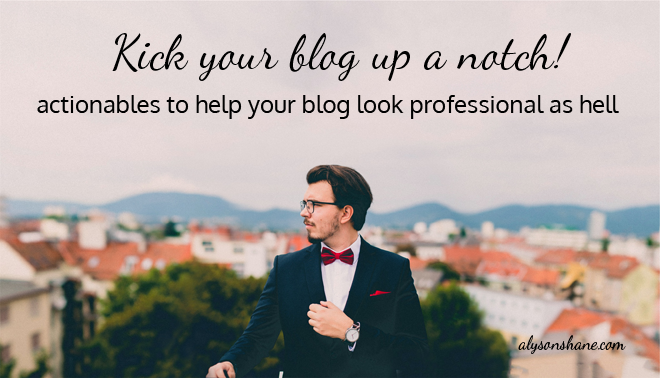
Clean up your layout
Remember the days of the early internet, back before we really thought about things like user experience and a clean, functional layout? If you don't, check out the Wayback Machine which is a handy little archive of what websites used to look like.
By and large they all sucked.
In fact, even my old layout kinda sucked. Let's take a look:
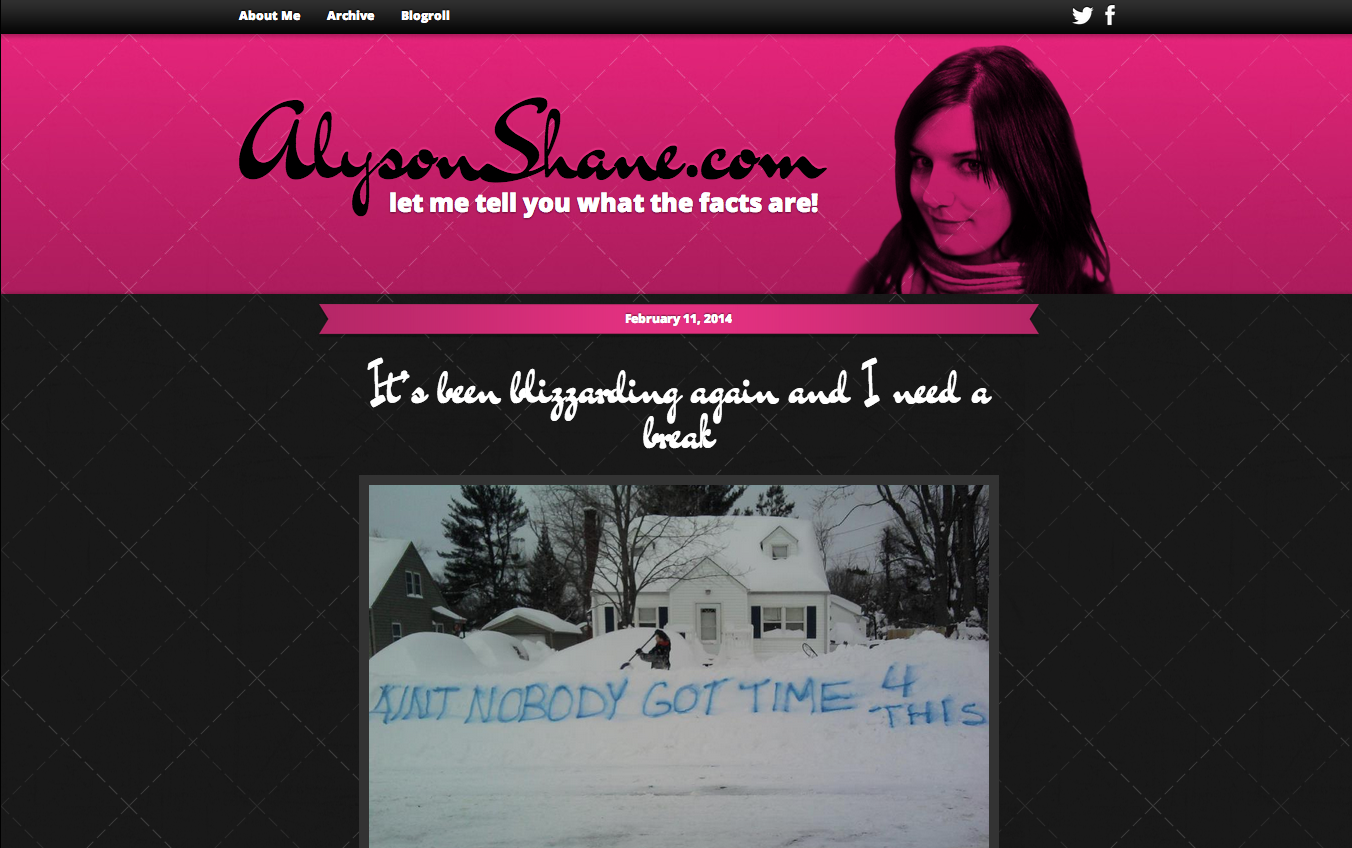
Ouch, right? Abrasive colours, no real flow, no real navigation... a very basic and (let's face it) pretty immature-looking site. Nobody visiting this website would have taken me for a professional creative-type.
This is because an abrasive, clunky-looking site demonstrates that you're not really serious about what you do; it immediately tells visitors to your blog you haven't put the time, energy and effort into making it represent you in the best way possible.
Not just that, but it shows that you aren't taking your visitor's experience into consideration, either - people won't stay on a site that's hard to read, especially a blog.
So what can you do? Here are a few steps that you can take to clean up your layout:- Stick to the basics. Darker text in a white or off-white background is easy to read and isn't painful to look at.
- Don't go font-crazy. Find a header font and a regular text font and stick to them. Google Fonts has some great free resources (thats's where both of mine, Dancing Script and Oxygen, come from)
- Rethink your layout. Visit your favourite blogs and make a list of the things that you like about them - what colours do they use? What sorts of layouts do they have?
- Need inspiration? Moodboard it out! I used Niice to create a mood board with design and style inspirations which helped guide my website re-design. You can check the one that I created here.
Get professional photos taken
Having nice, professional photos can make all the difference in how seriously people will take you and your blog. Selfies have their place, but that place shouldn't be on your sidebar or bio page!
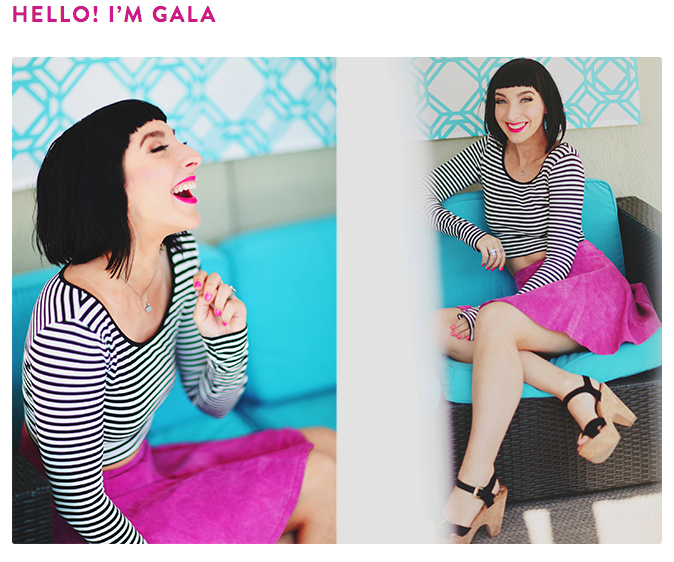 I've always loved Gala Darling's amazing photos; they really showcase her personalty and look stunning. You don't have to go high-fashion (or even pay through the nose for a professional session) though, just a decent camera and some good lighting makes all the difference!
I've always loved Gala Darling's amazing photos; they really showcase her personalty and look stunning. You don't have to go high-fashion (or even pay through the nose for a professional session) though, just a decent camera and some good lighting makes all the difference!
Shop around and see what local photographers are charging for portrait sessions; it might seem like a steep investment up-front but I guarantee you that having some beautiful, professional-level photos will not only make your blog look better, but you'll feel better about sending people to check it out.
(Shameless plug: my photos are via the super-talented Palma Photography. If you're in Winnipeg or the surrounding area I highly recommend working with him.)
Review brands & experiences you love
Many big-time bloggers do "sponsored" posts where a brand sends them a product, invites them to an event, or provides them with a free experience in exchange for coverage on their blog.
If you're just starting out this might seem daunting - how do you let brands know that you're ready, willing and able to start working with them? Easy: Write up a post reviewing a product or experience that you had and show them what you can do!
I don't mean lie about being sponsored by a brand, but rather simply write a review with some nice images or graphics (preferably ones that you made yourself, you clever thing.)

A great recent post in style that I recommend checking out is Sarah from Sunshine & Mint, who recently blogged about her natural skincare routine, and reviewed the products that she uses on a regular basis. It's that easy!
Additionally, make sure to link to any brands you mention in your post, and in any posts you create on social media! This means linking to their Facebook page in your Facebook post, @mentioning them on Twitter, etc. This dramatically increases the likelihood that the right people will not only see your post, but will want to work with you in the future. At the very least, an astute social media manager will share your post with that brand's audience, which will bring more people to your blog.
Include links to recent posts/projects
Whether someone is visiting your blog for the first time or is a longtime reader, making sure that they can easily find links to your other work is a great way to show off your content and increase engagement.
If you're a blogger with lots of projects, helpful content, or multiple-post series, consider creating a 'projects' page like I have, or link to the in your sidebar to help people find them (Ashley of A Silver Twig does a great job of this on her sidebar, in case you're looking for examples)
Other helpful stuff your blog should include is:
- Recent Posts section with links to your most recent content
- Older Posts or Archives section or list. I keep mine on my sidebar and it's organized by month, but lots of other bloggers like Tony Pierce put theirs at the bottom of their page.
- Projects or similarly-named page for longer, more in-depth projects. This serves as a place where readers can easily find and navigate around related posts.
- Footers linking to other related work, eg: "this post is part of a series, click here to see more!"
Make your social media links easy to find
Prominently displayed social media links encourage readers to interact with you across multiple social platforms - if they like your blog they're likely to start following you on Twitter, connecting with you on Pinterest, or wherever you may be.
Additionally, showcasing the multitude of ways that you're connected online also demonstrates how social media-savvy you are. Just make sure that you're linking to active profiles! Nobody wants to engage with a dead and forgotten profile.
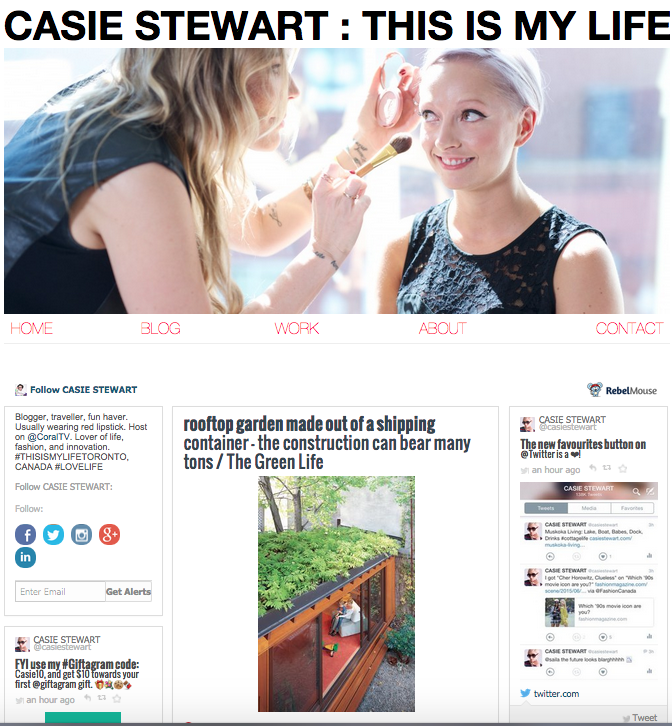
Bonus: If your site layout allows for it, RebelMouse is a great widget which will pull all of your content from a social media feed (mine pulls my Twitter & Tumblr) and show it on a single page. I snagged this idea from blogger superstar Casie Stewart, who uses it as the landing page on her personal website, and I love how it looks.
Include a copyright in your footer
Even though you have a built-in copyright on original material that you publish online, a little copyright at the bottom of your page is a handy reminder that the content on your site is yours, and helps add a more professional feel to your content.
Include calls to action
An easy way to help people find your other posts, subscribe to your newsletter, or interact with your post is to include calls to action throughout your blog.
For example, there's a call to action at the bottom of my posts which looks like this:
I've written about the importance of newsletters in a previous post, but let me just say this: newsletters are one of the most powerful tools that you have to communicate with your audience.
This is because when people sign up for your newsletter they are saying "yes, I confirm that I want to hear from you on a regular basis!" and are granting you permission to send your content directly to their inbox. No worrying about social media algorithms, sites getting shut down, etc. You always have a way to communicate directly with your audience.
You can also include calls to action in the body of your posts by ending a post with a question, or series of questions meant to engage your reader and encourage comments. By asking questions or actively asking for suggestions, you show your readers that you want to interact with them and increase the likelihood that they'll comment, share or subscribe.
Share what you know (be a thought leader)
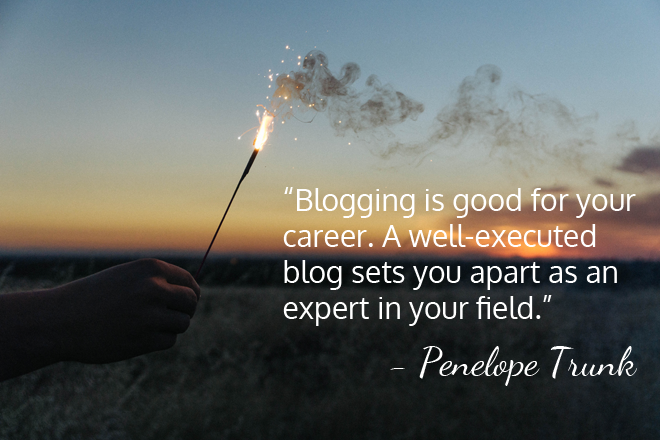
I love that quote from powerhouse (and one of my personal heroes) Penelope Trunk.
Blogging is about having something to say, and saying it well.
Don't just share what you know, share why you feel it's important knowledge. Be descriptive, be creative, and be daring. Think about the things that matter to you as a person, as a business owner, as a creative, whatever, and get writing about it.
Have you been building your business from the ground up? Blog about that. Do you have keen insight into B2B marketing? Blog about that. Have you built a mini internet empire painting watercolours of sloths? Blog about that!
Put yourself out there and show your audience who you really are - that's what will keep them coming back, after all.
Do you have any additional tips for making your blog better? Any horror stories of blog layouts past? I'd love to hear them!
Before & After Blogging: A Handy Post Checklist
- by Alyson Shane
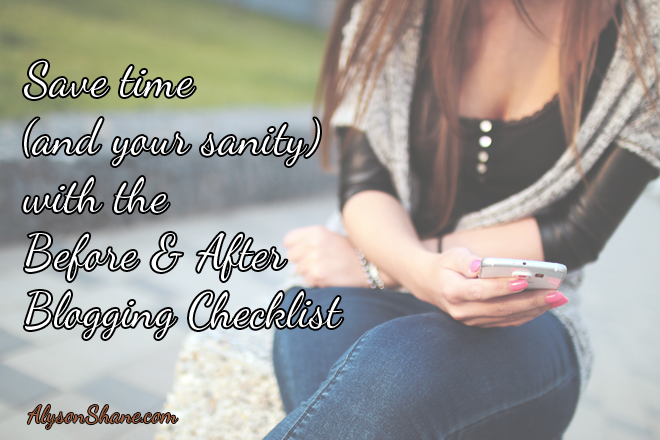
When I first started blogging (way back around 2003) things were easy. You wrote your post, hit 'publish' and other people's RSS feeds took care of the rest.
Nowadays things aren't so simple. Bloggers need to worry about things like search engine optimization, keyword inclusion, social media promotion, image design... the list goes on!
If you're new to blogging the amount of steps needed to make sure your post gets the attention that it deserves can seem really daunting, and even for a veteran blogger like me when things get crazy-busy it can be a challenge to make sure I'm taking all the necessary steps to promote my latest post.
With that in mind, I've put together a handy little resource for you (and me!) to use.
The Before & After Blogging Checklist is a simple little tool which helps keep track of the things to do before and after a post goes live. This helps me stay organized and on-track, and hopefully it will help you do the same!
You can view it here, or download it below for easy everyday use!
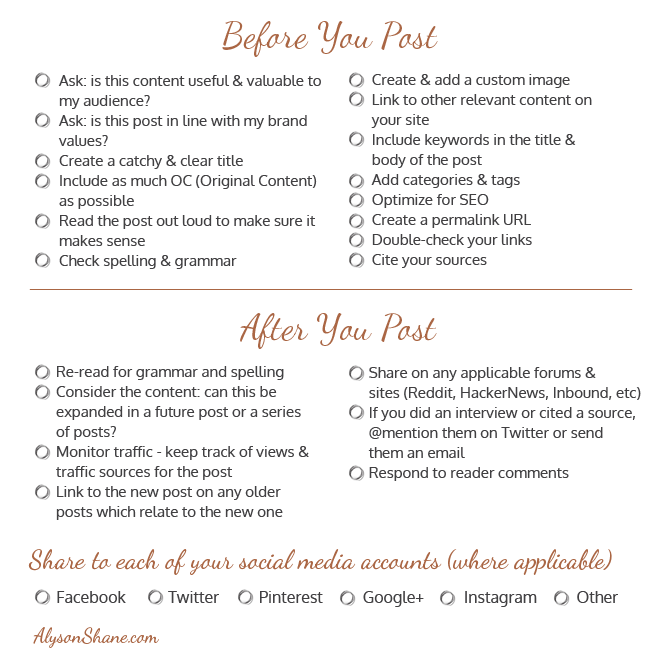
Want to keep a copy for yourself? Download it here:
